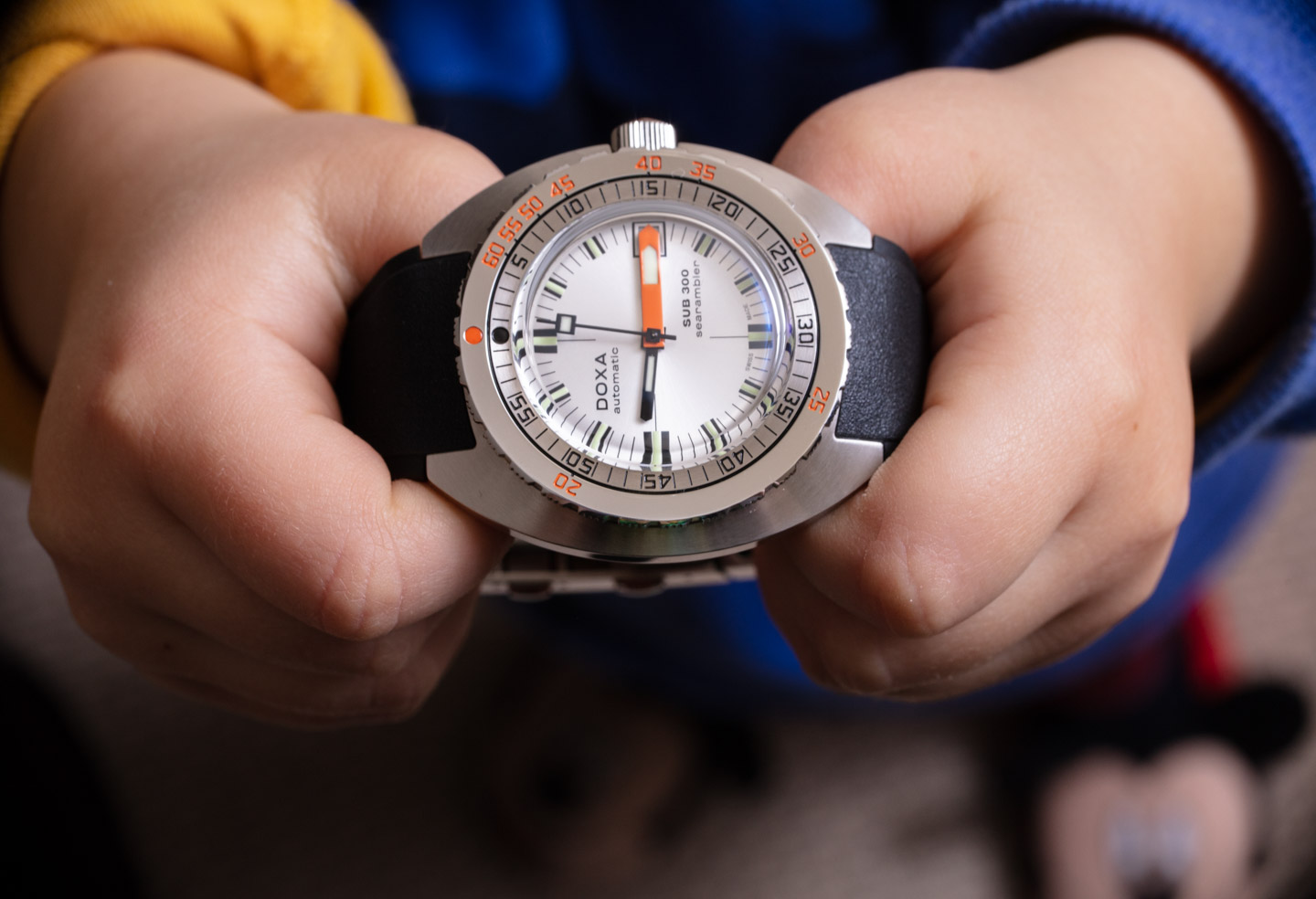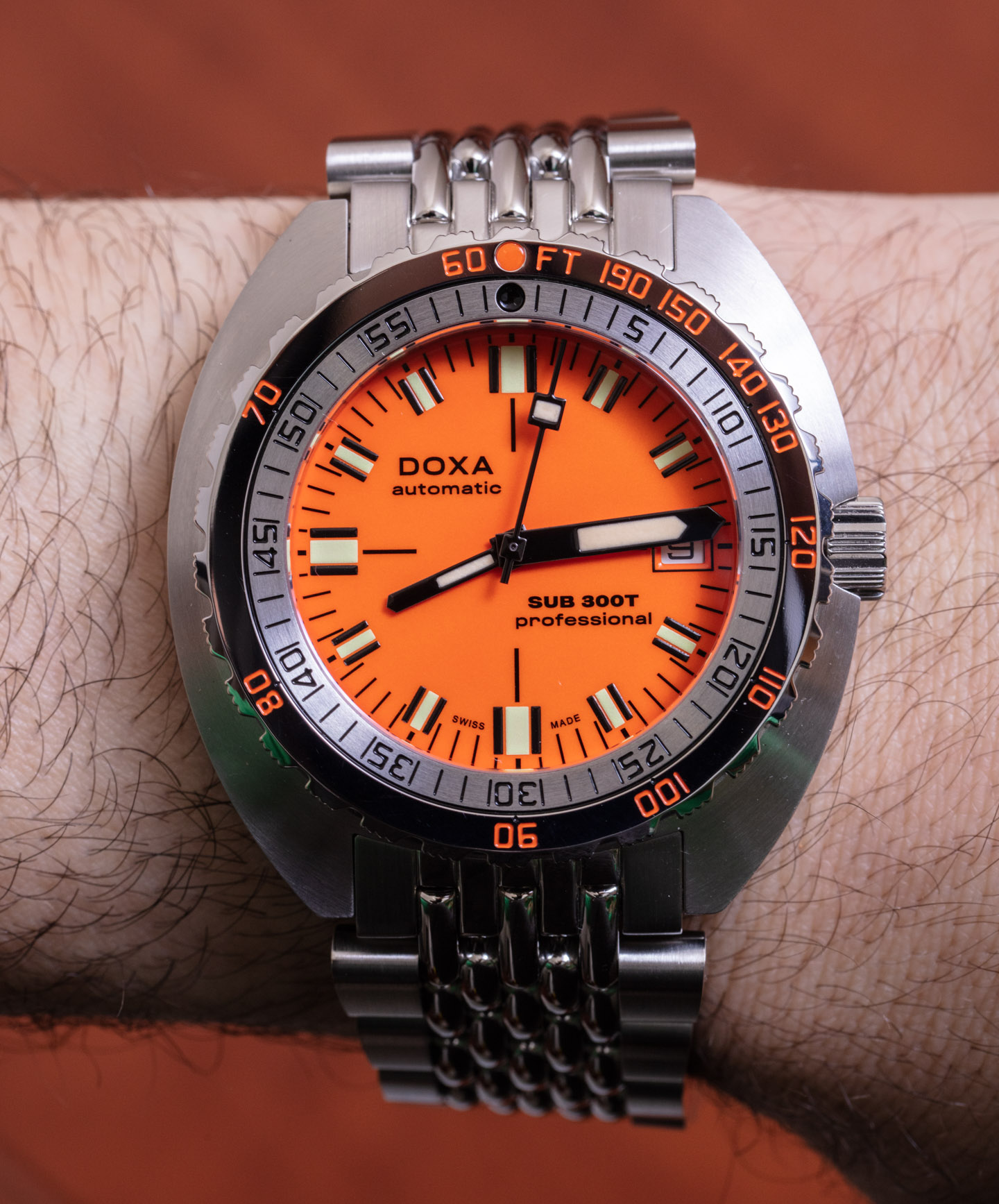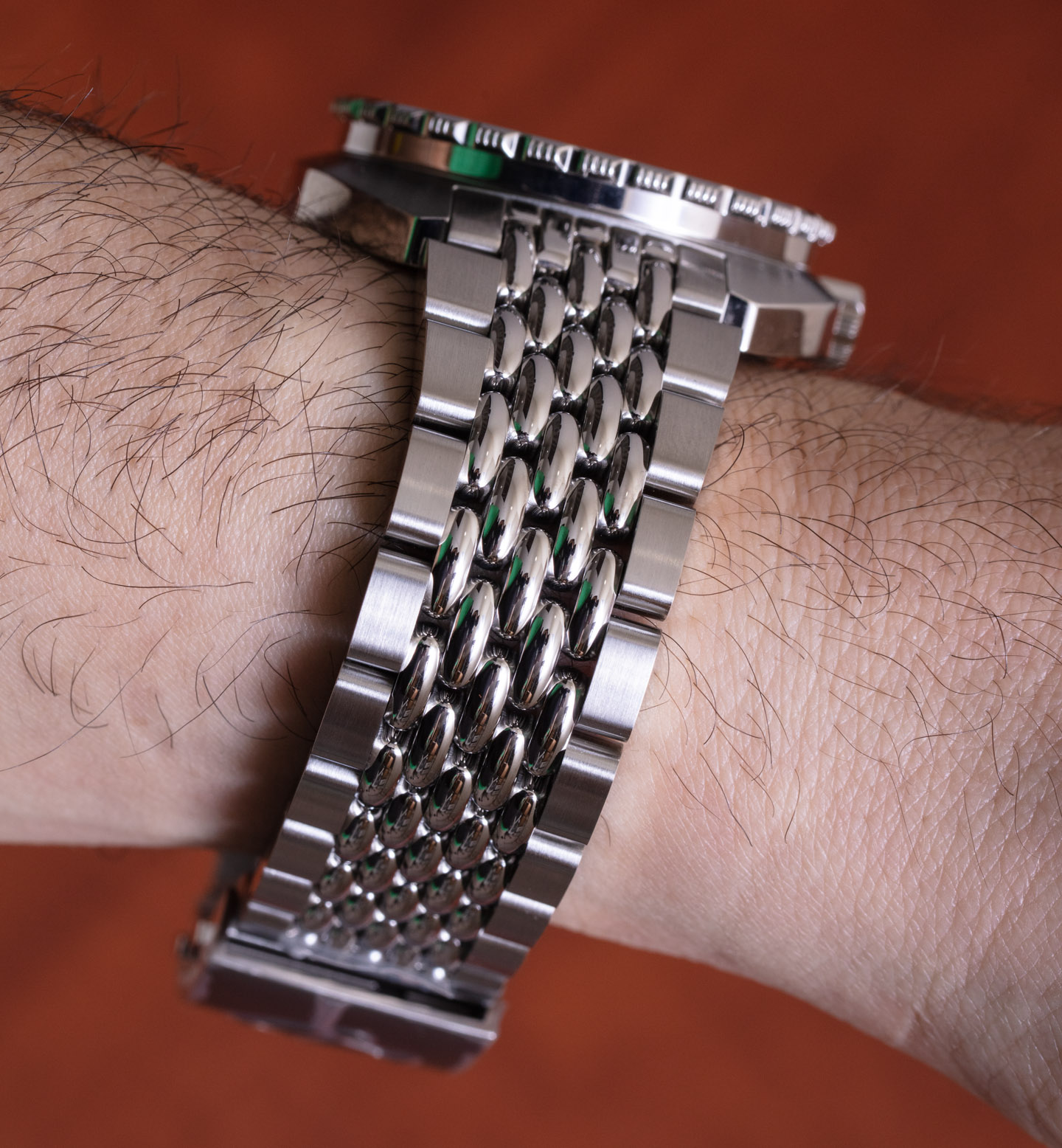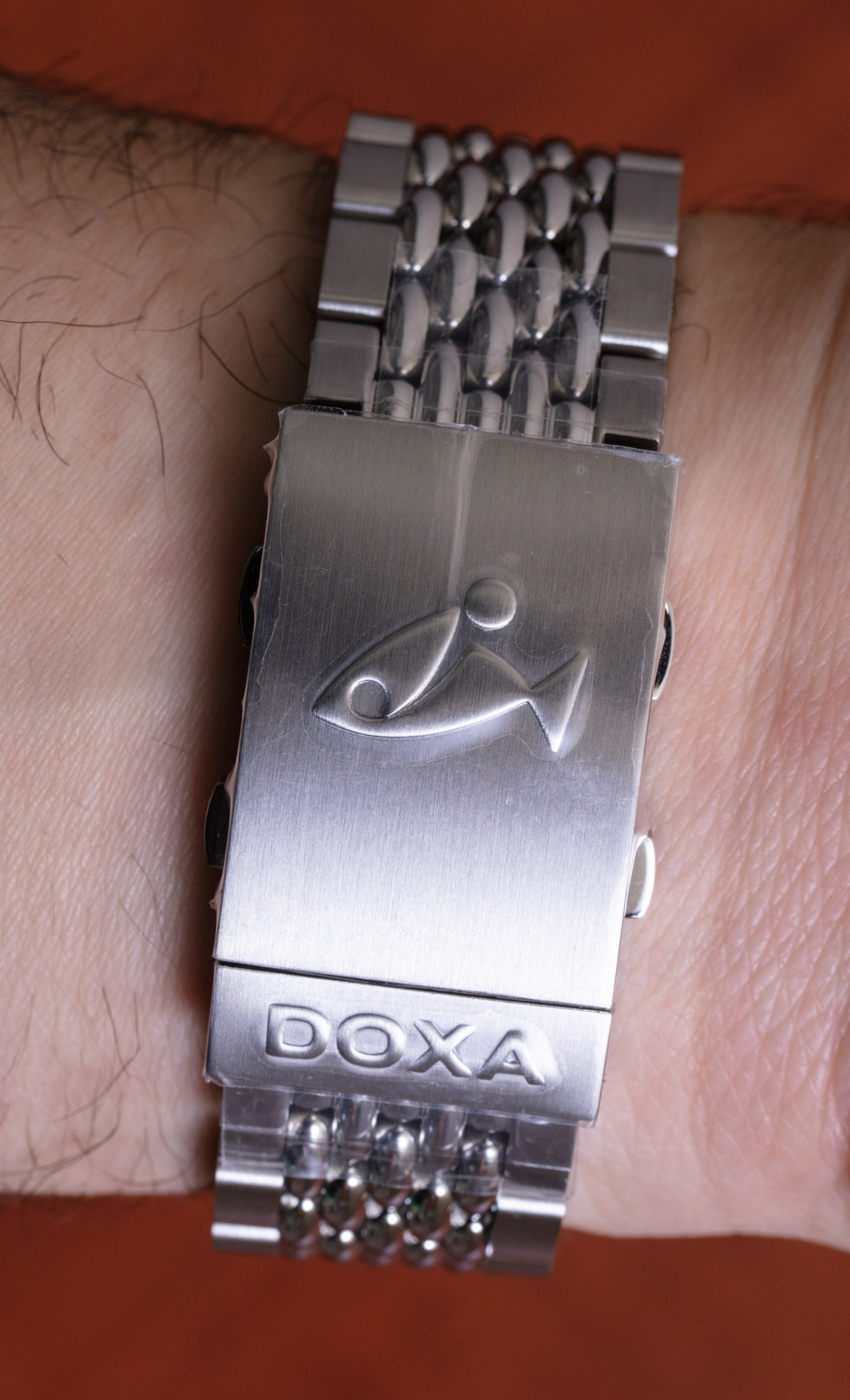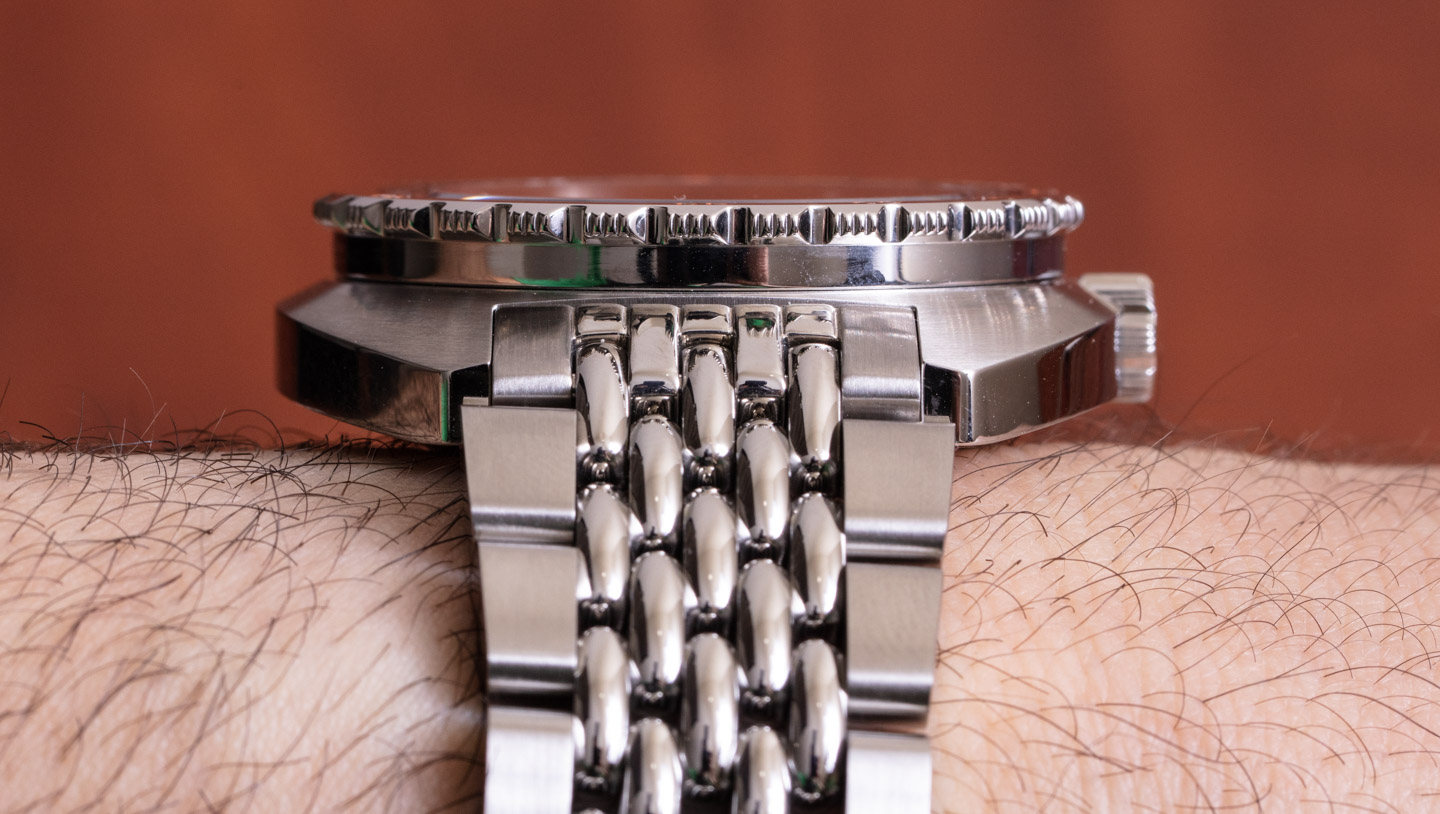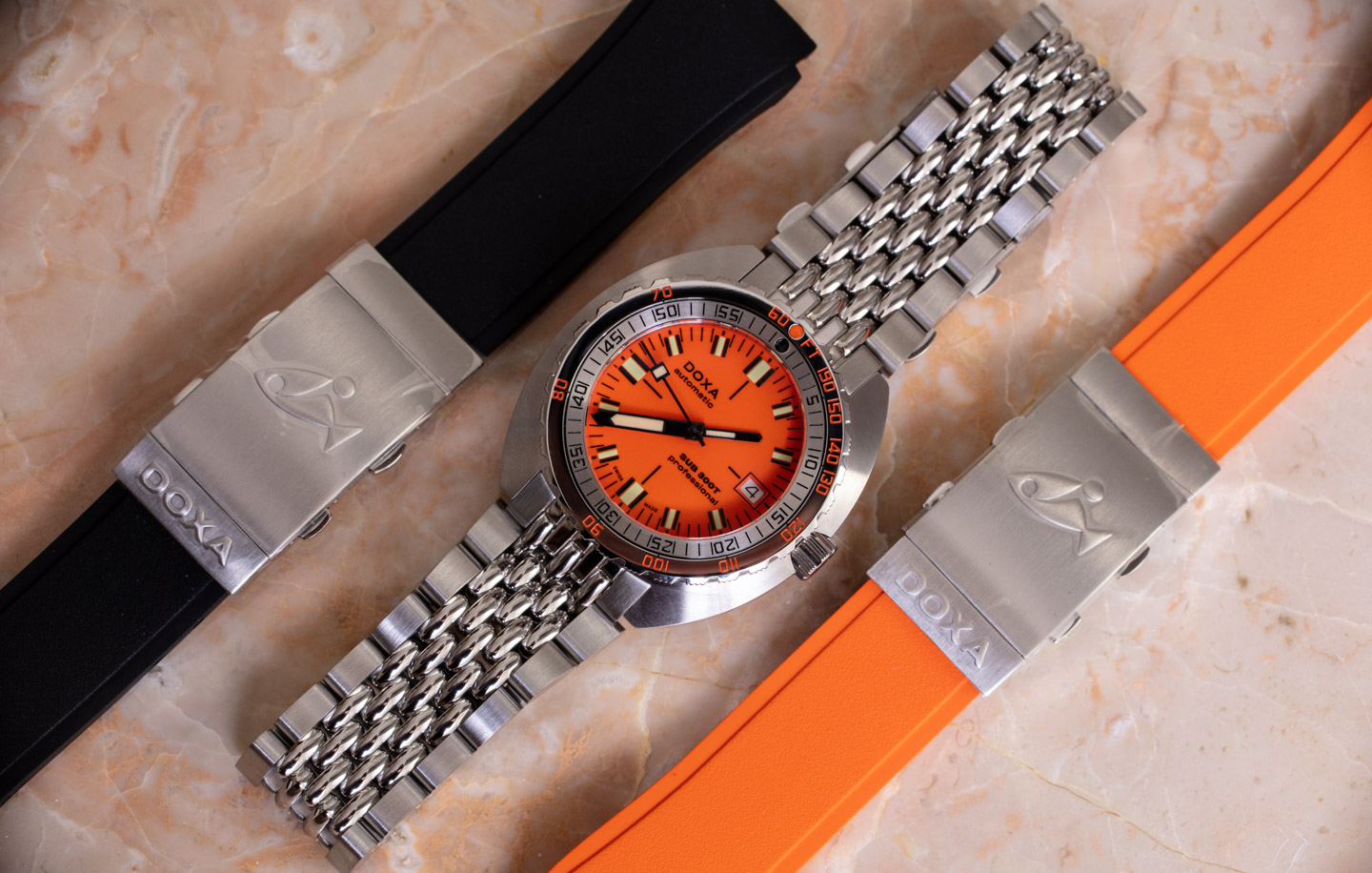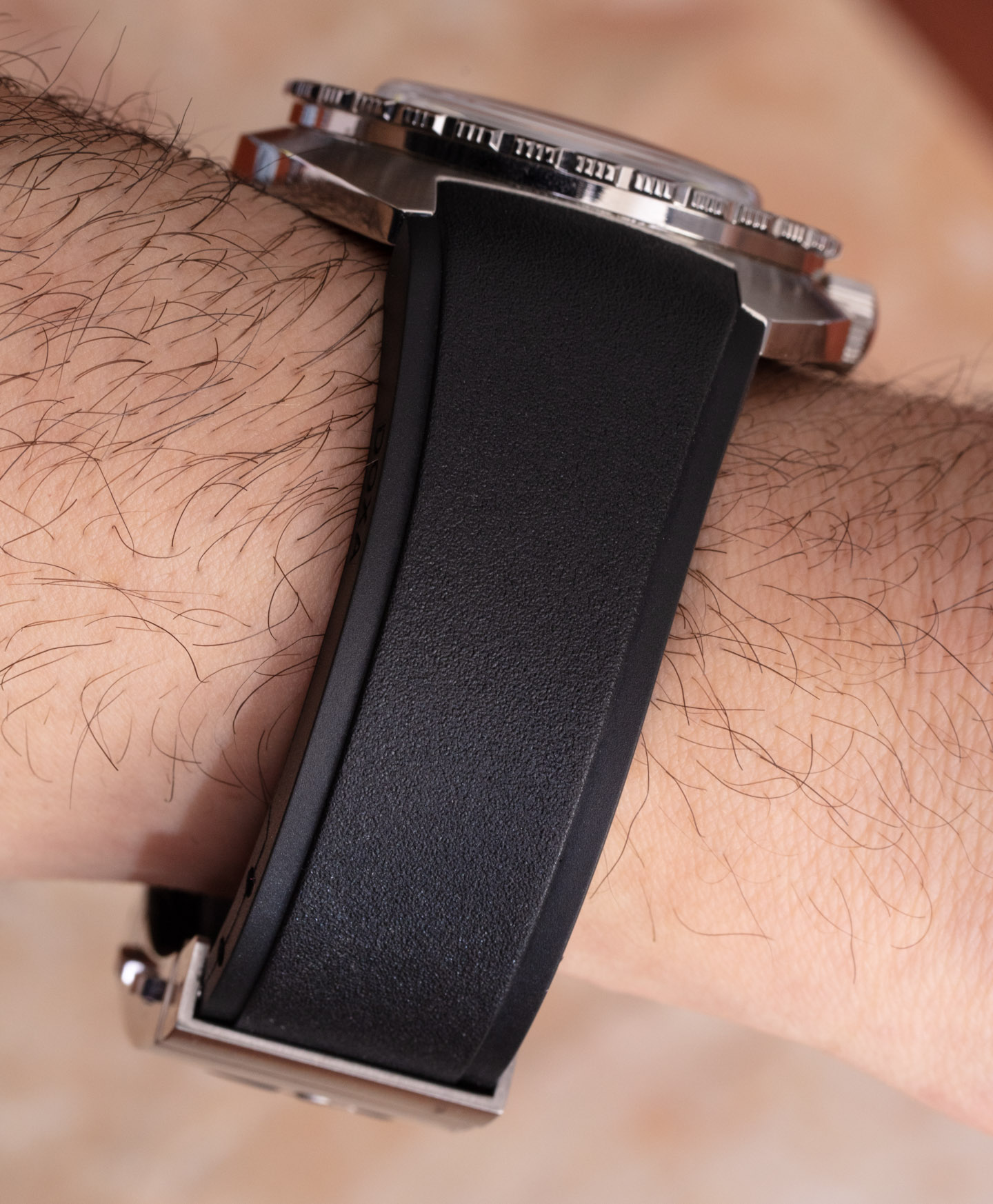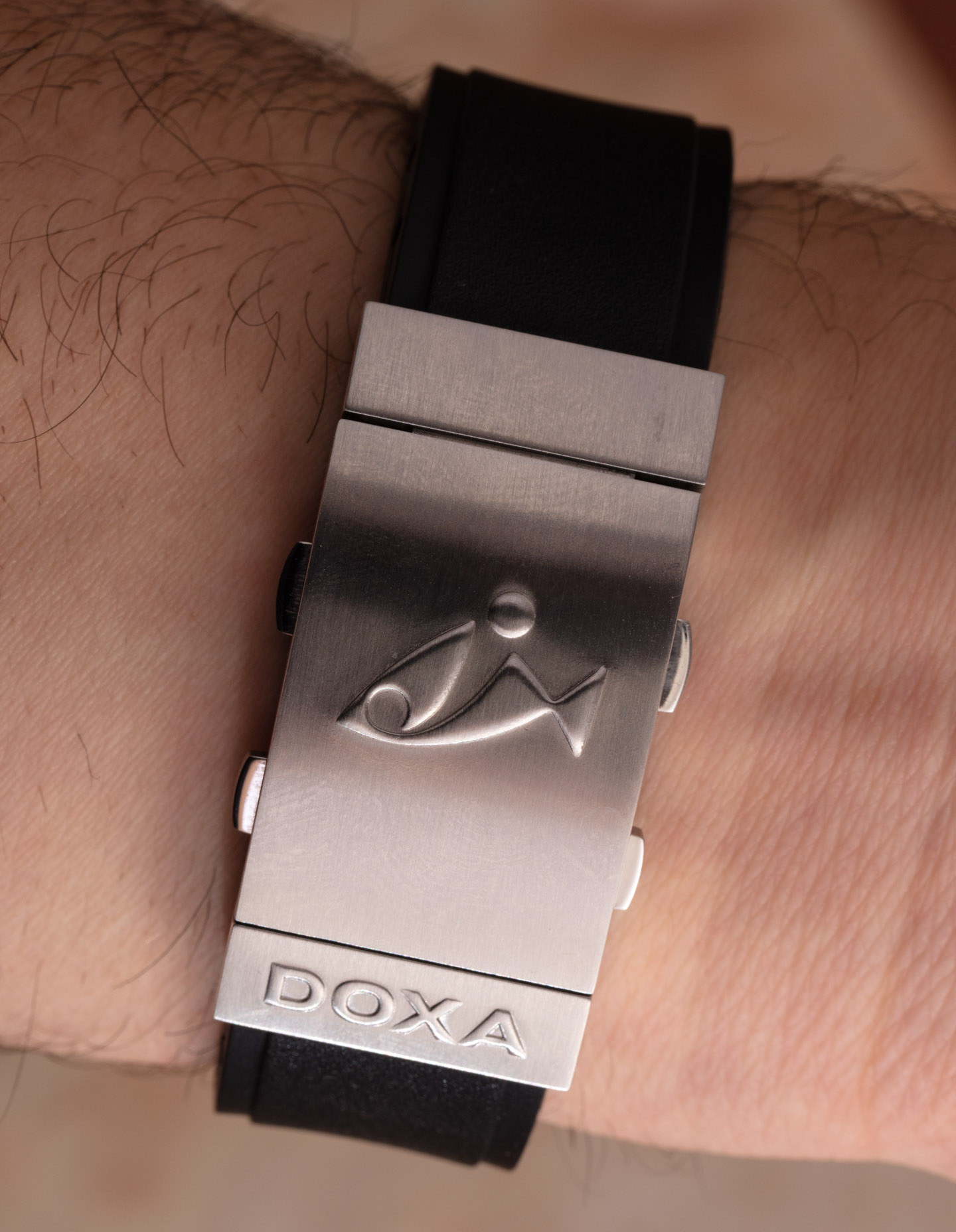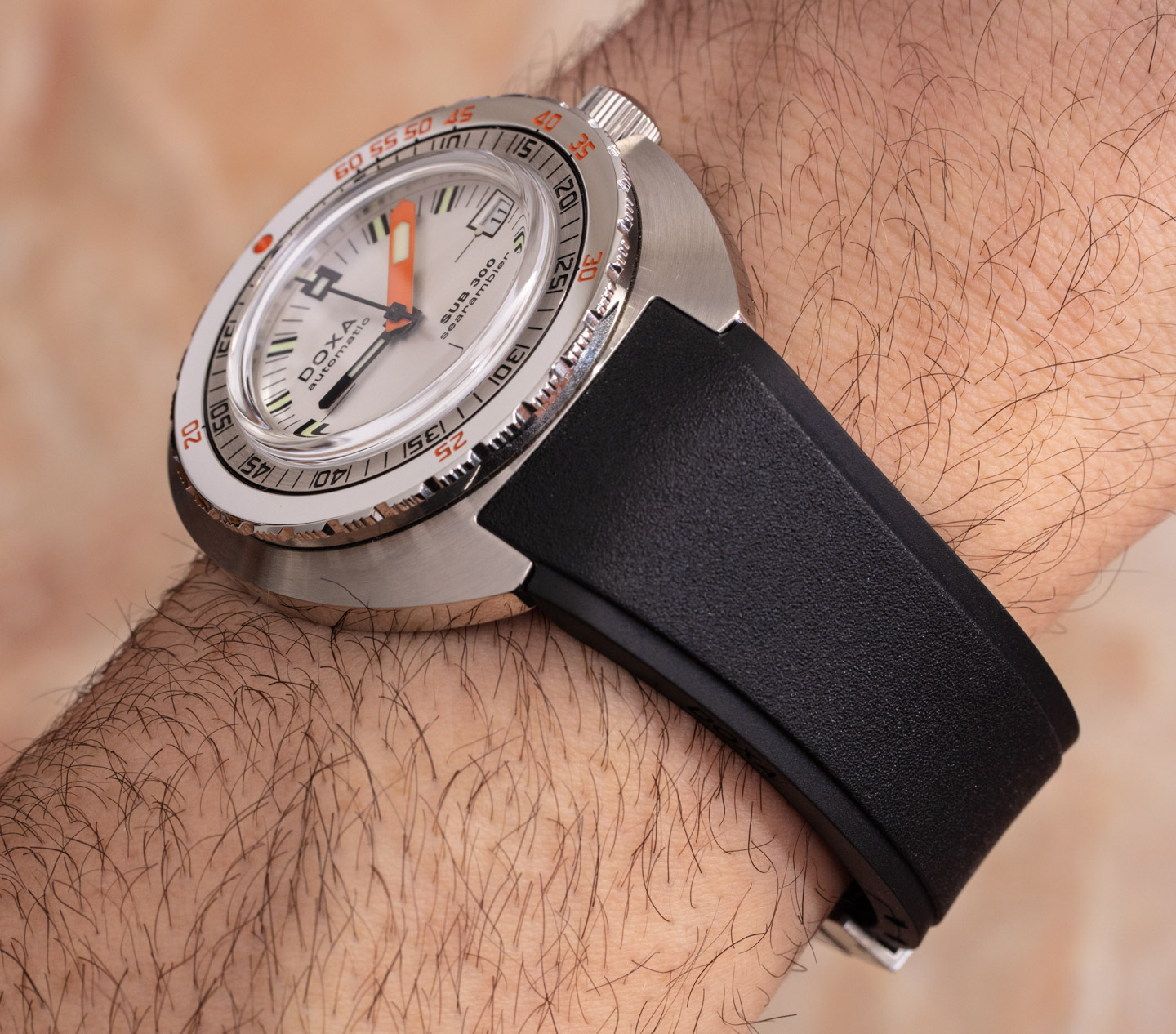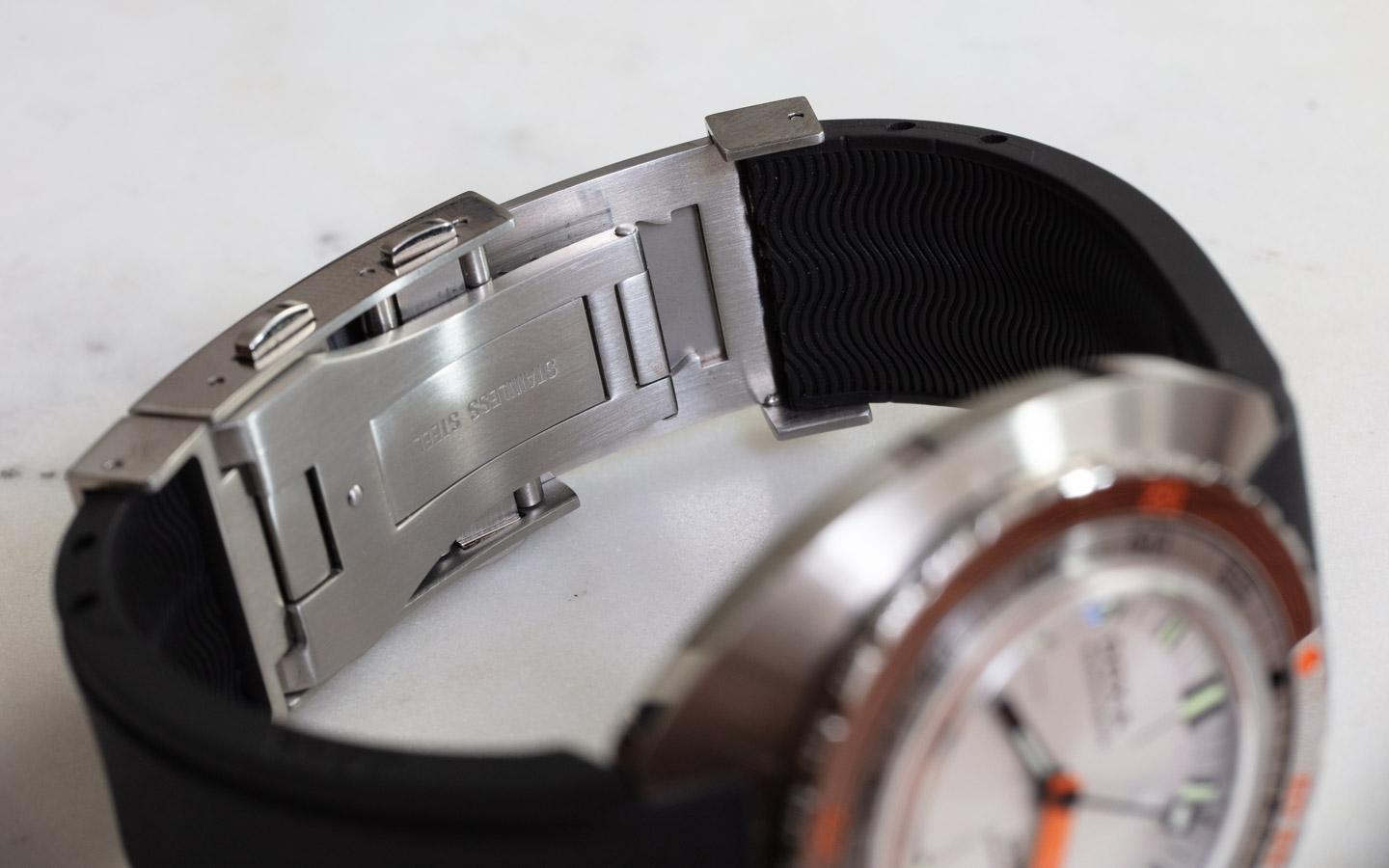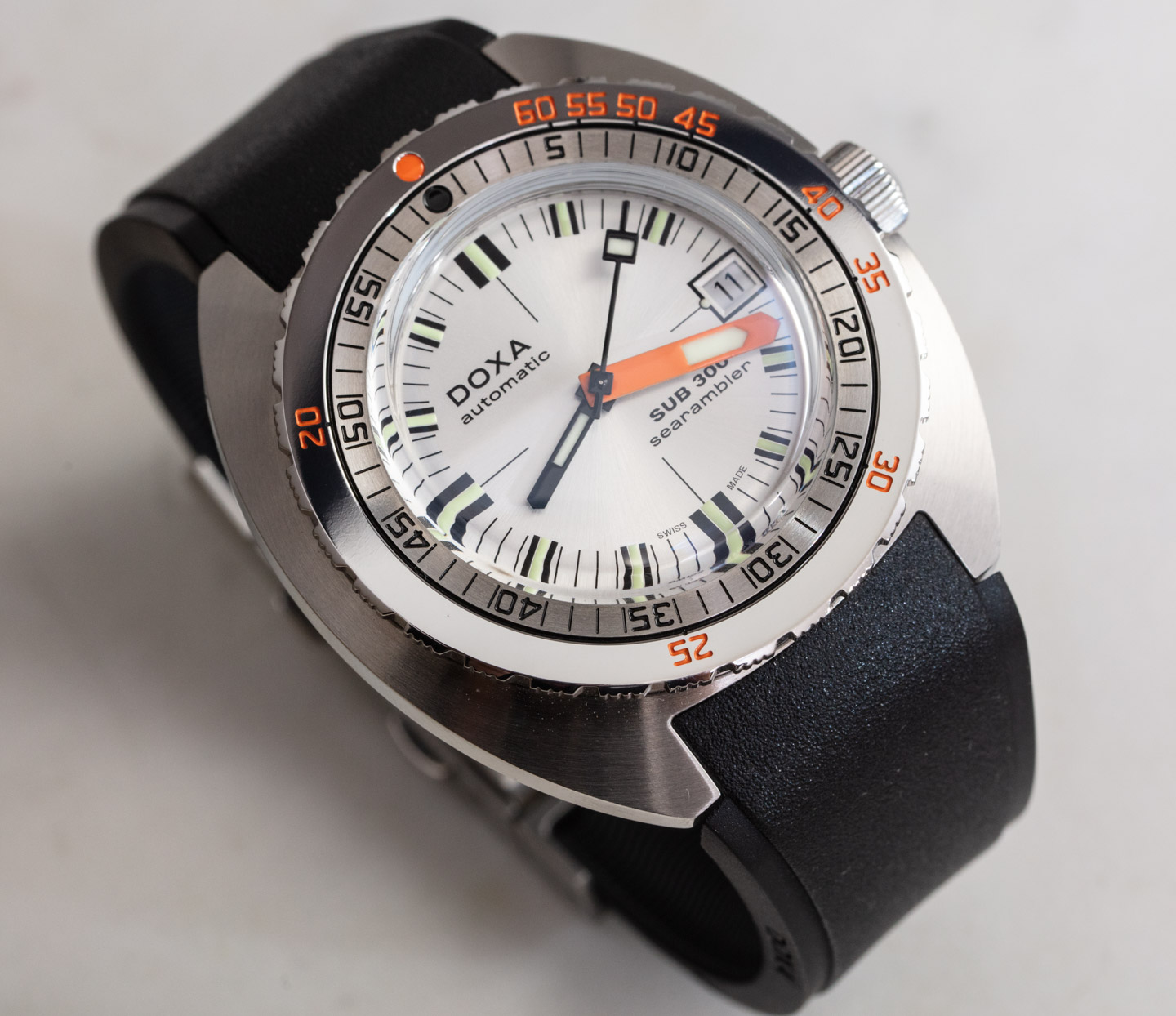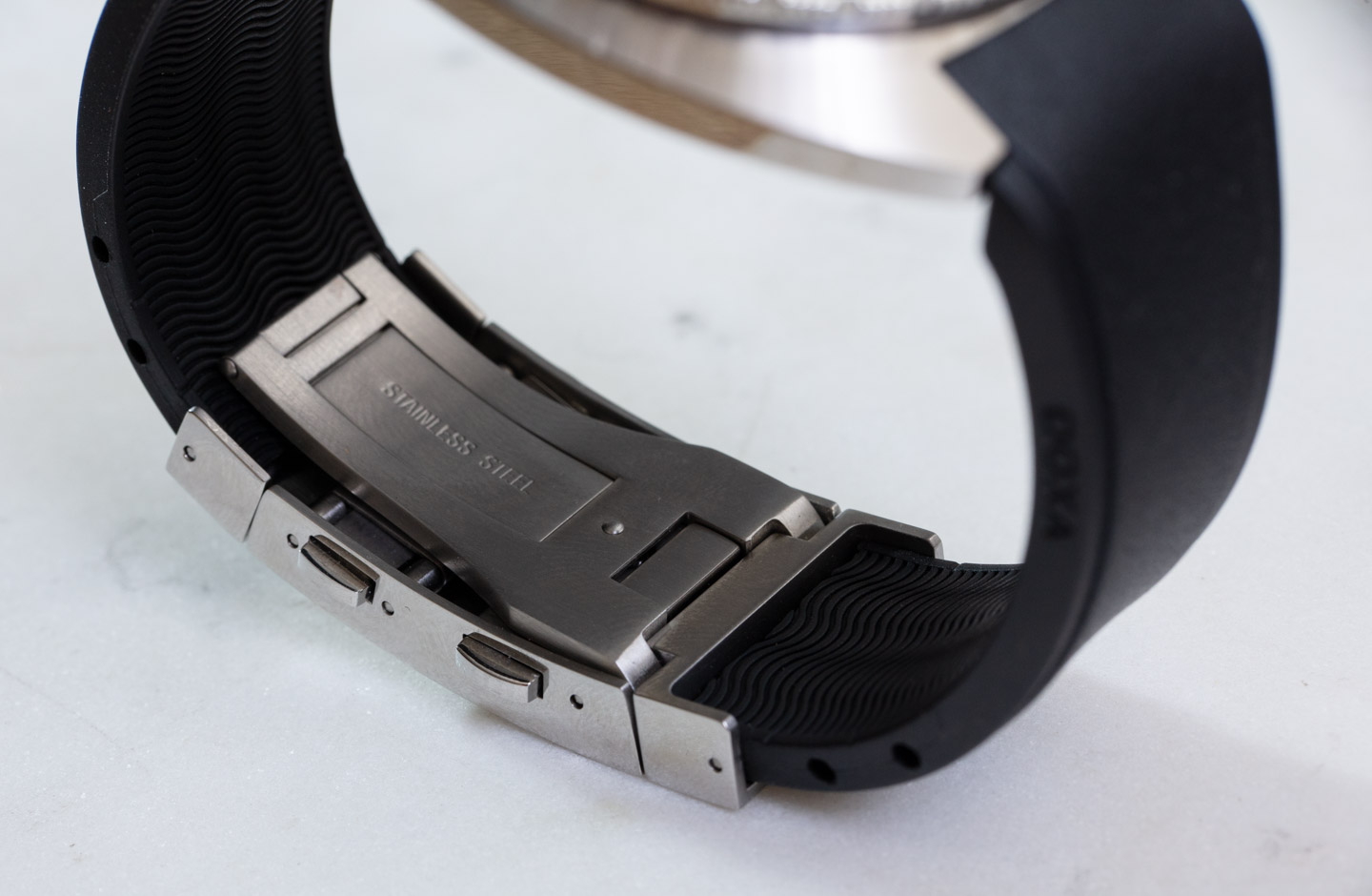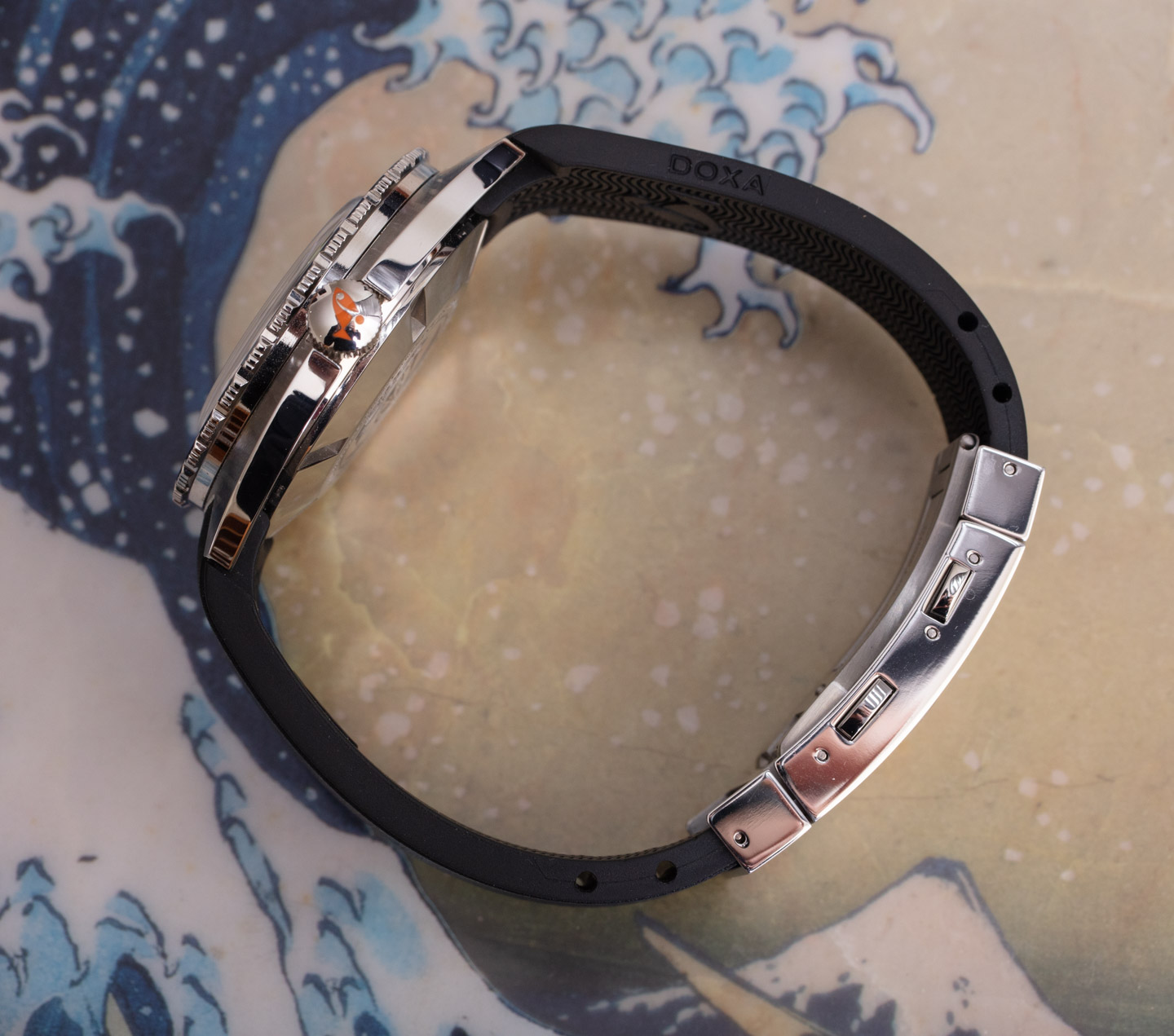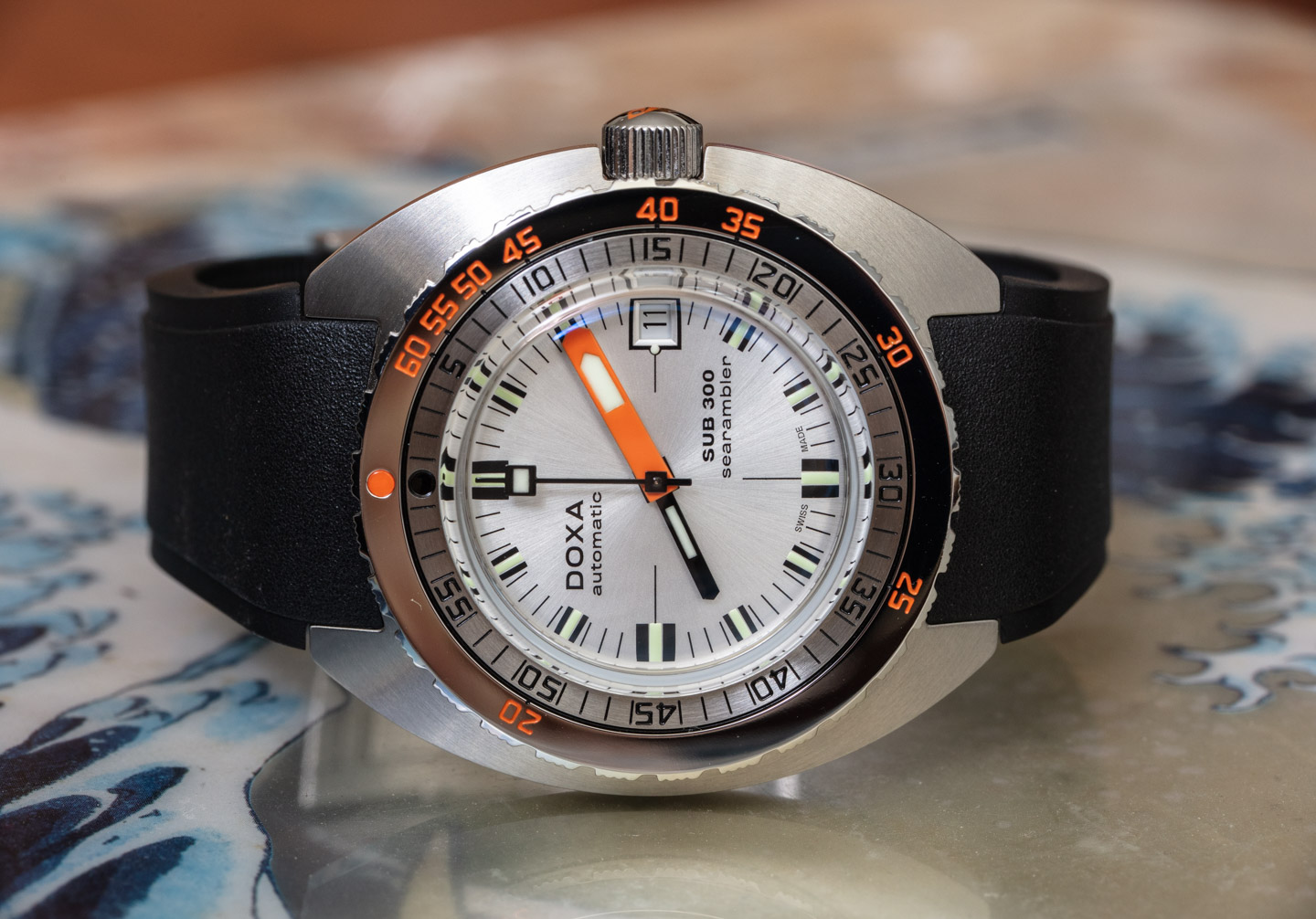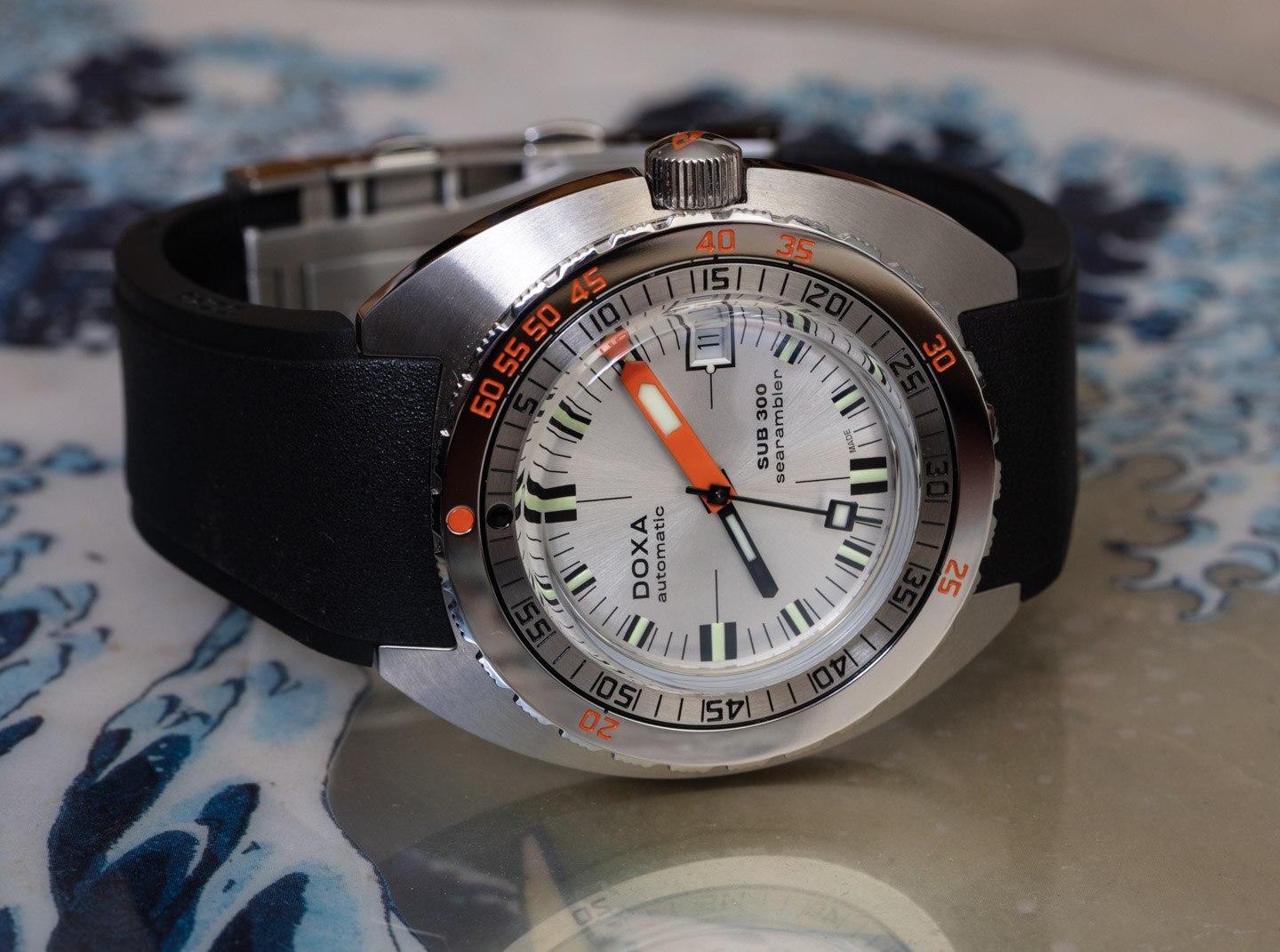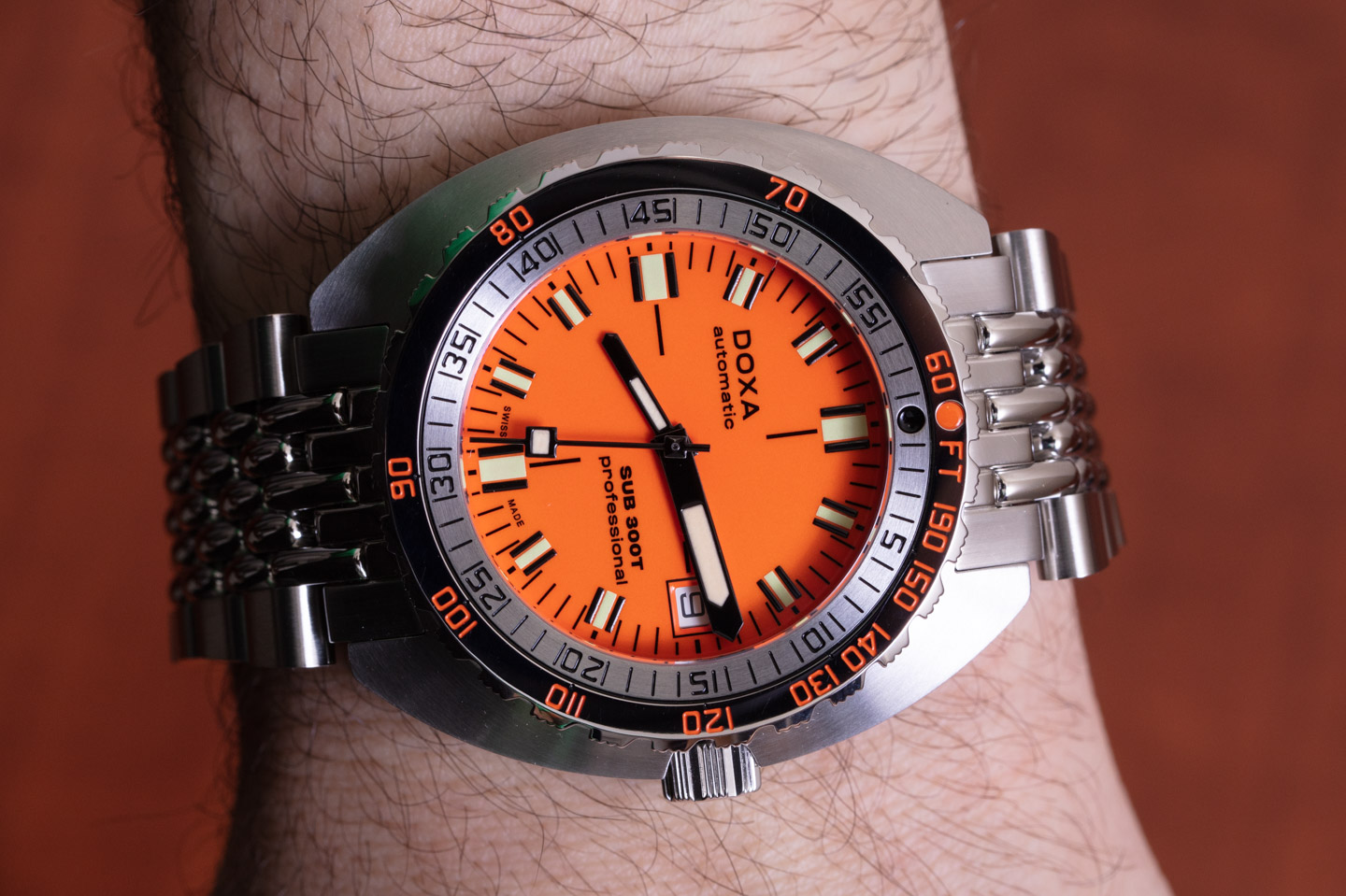
Doxa has always been one of those interesting “cult favorite” watch brands even though it has a traditional Swiss watch brand history and a product legacy peppered with a number of watches — including a lot of dress models. The “cult status” of Doxa has specifically made its diver’s-style watches popular, and for many good reasons. Doxa watches receive more than their fair share of enthusiast support, and today on aBlogtoWatch, I review the Doxa SUB 300, as well as the very similar SUB 300T. As of 2020, the Doxa SUB 300/300T comes in a total of six dial colors, each with a unique product name and available strap in addition to the iconic “beads of rice” style diver’s bracelet.
Before talking about some Doxa dive watch history, let me first explain why this watch review actually covers two product families. Currently, Doxa produces two watches that are inspired by its original late 1960s diver’s watches. This includes the Doxa SUB 300 and the SUB 300T. Both watches are solid options, but that Doxa offers two timepiece collections that are in many ways the same is part of the interesting quirkiness of the brand. While there are small differences in proportions and size between the SUB 300 and the SUB 300 T watches, consumers would be forgiven for mistaking the two at a glance. Thankfully, Doxa labels the watch dials with their name so that confusion happens a bit less.
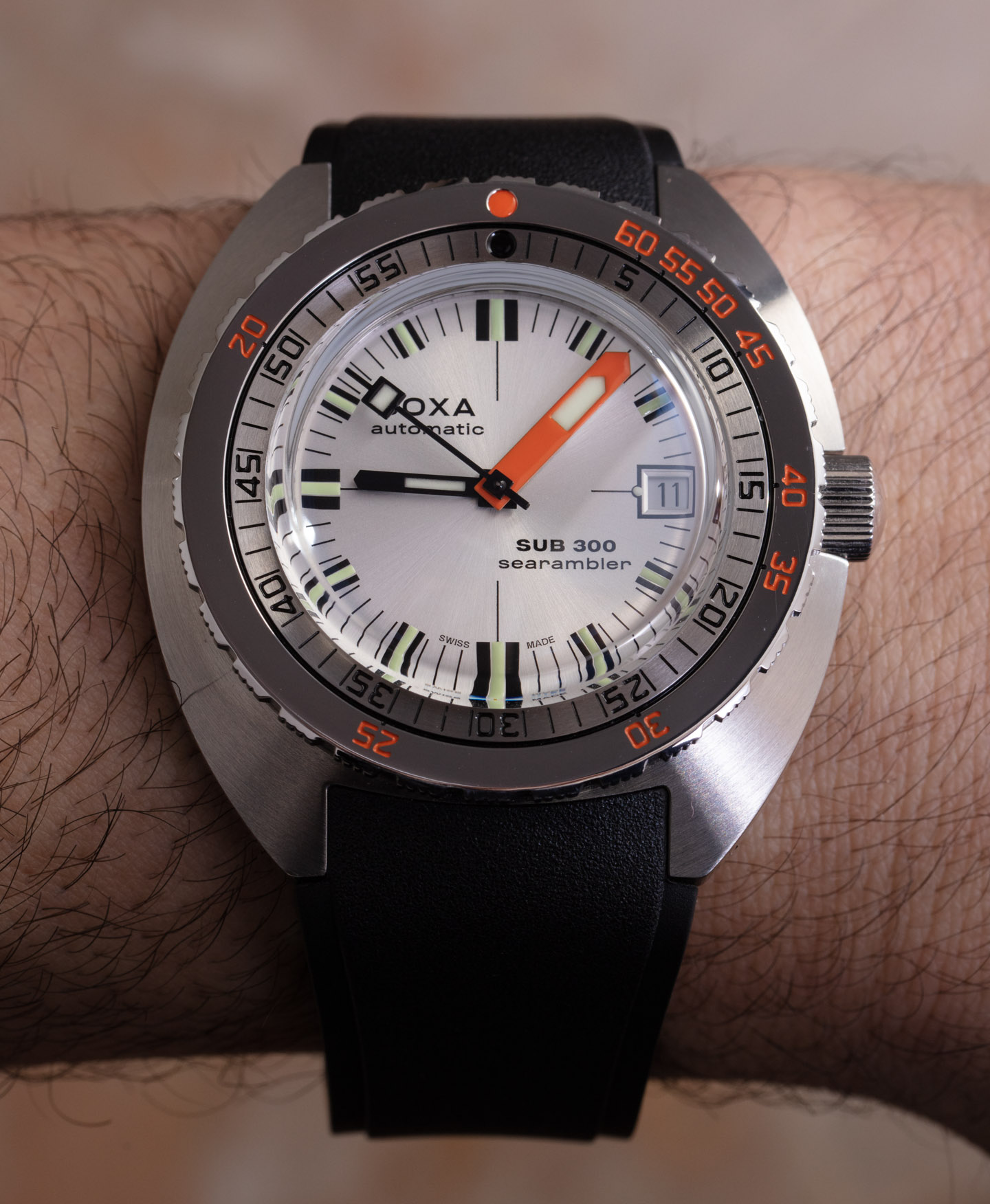
What makes the SUB 300 and SUB 300 T different? In short, price, size, water resistance, and movement features (for the most part). But I would say that, given how similar these watches look (virtually identical, really), there is not a clear winner between the two — they are both nice watches. The SUB 300 is a bit more expensive, but not always for obvious reasons. The SUB 300T is a modern homage to the 1969 Doxa SUB 300T Conquistador and while less expensive, is the more capable diver’s watch for those who need more serious features.
The Doxa SUB 300 is 42.5mm-wide with a 45mm lug-to-lug distance. The polished and brushed stainless steel case is 13.4mm-thick, and inside the watch is a Swiss Made ETA 2824-2 automatic movement that has been given a COSC Chronometer certification. The case is also water-resistant to 300 meters. Like the case, the matching steel bracelet is a bit thinner for the SUB 300 versus the SUB 300T. The SUB 300 also has a retail price that is $600 USD more than the SUB 300T.
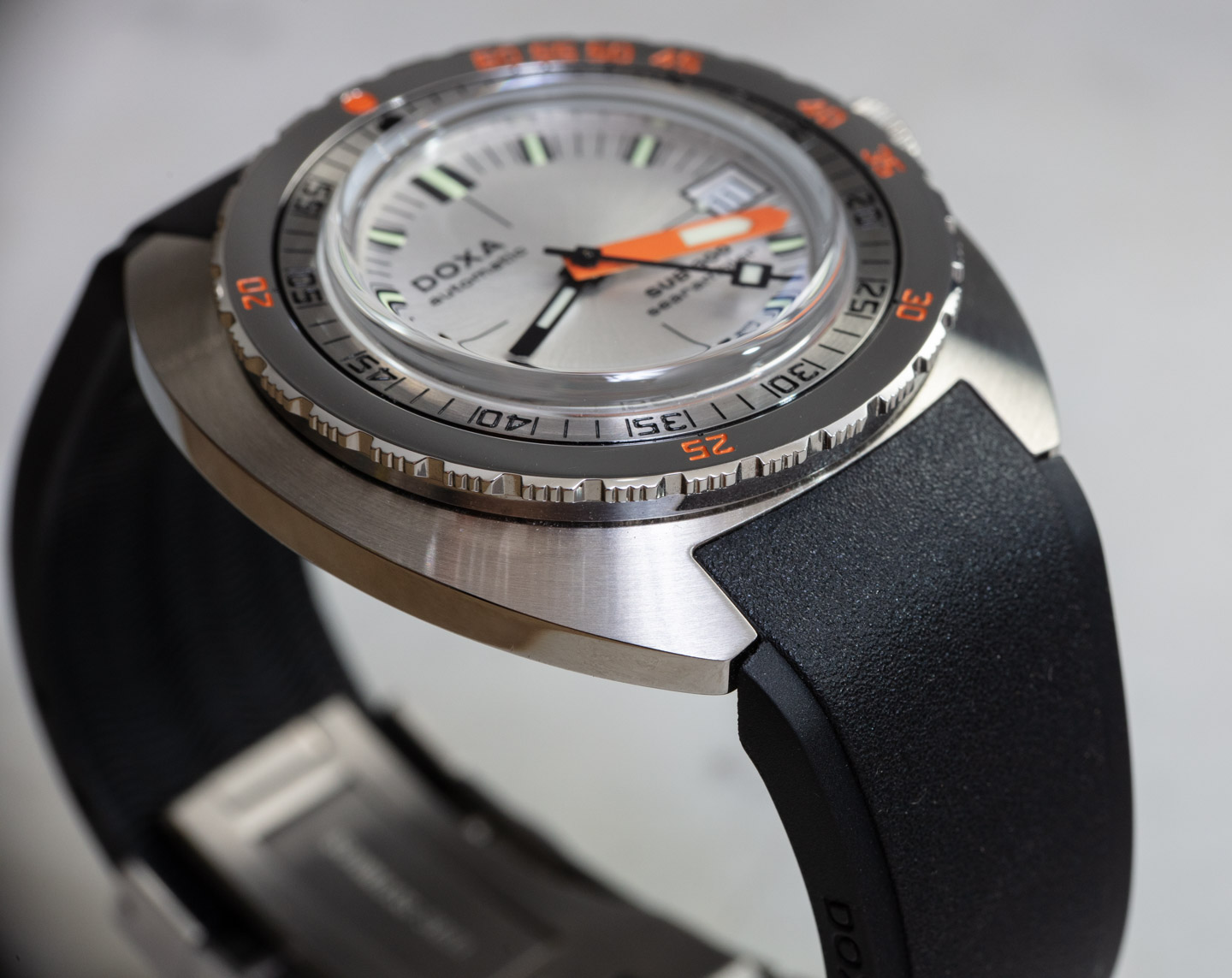
The SUB 300T, on the other hand, is a bit larger, but mostly in proportions and thickness. It doesn’t really wear larger, as it is half a millimeter thicker and actually a bit shorter (lug-to-lug distance) at 44.5mm-wide. This is due to the slightly stubbier lugs. Interestingly, the SUB 300T has a sapphire crystal that is more flush with the bezel, versus the box-style crystal of the SUB 300. This means that even though the SUB 300T is only a bit thicker than the SUB 300, it visually looks appreciably thicker given the more prominent bezel structure. Also, note that the SUB 300T has an automatic helium release valve on the side of the case.
There are some other minor differences between the two iconic Doxa divers, which include things like dial proportions and the style of the no-decompression time limit scale text. In my opinion, the SUB 300 is a slightly dressier (given the thinner size) and slightly more watch-enthusiast-focused model given its more refined proportions and COSC Chronometer-certified movement. If you need a heavier, beefier watch, the SUB 300T is the choice.
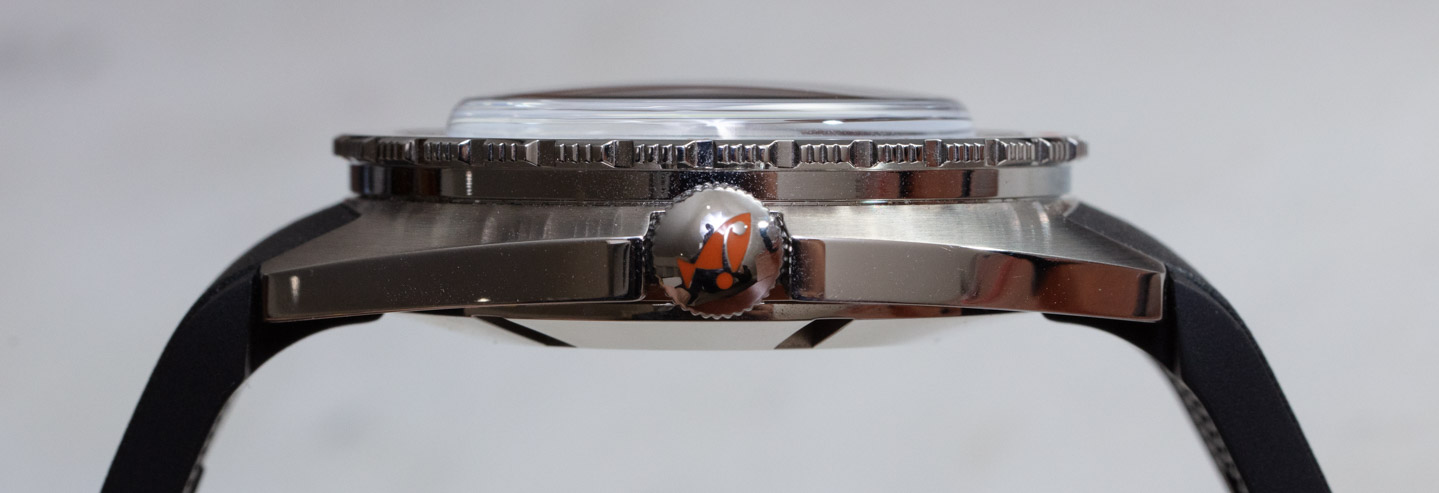
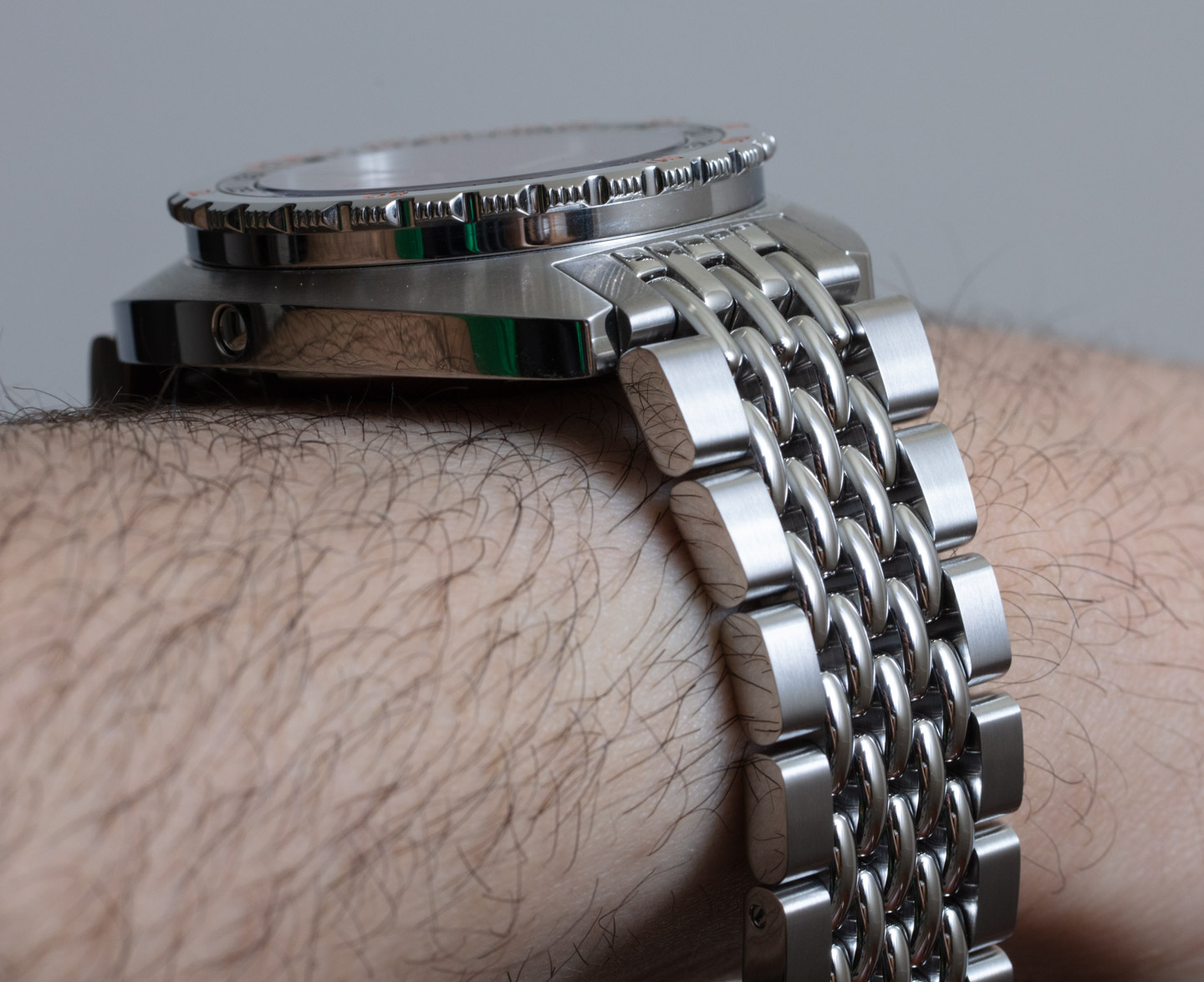
The Doxa SUB 300T is water-resistant to 1,200 meters. (Ironically, the original SUB 300T was water-resistant to 300 meters, but that is reserved for the SUB 300 model for the small percentage of dive watch wearers who need this functionality.) The steel case is the same 42.5mm width of the SUB 300, but it is a tad “shorter,” as I said. It is sort of interesting how the various measurement differences seem to suggest that even though it makes more sense from a product differentiation standpoint to have these similar watches be differently sized, Doxa did a lot for the SUB 300T to wear as small as possible given its overall heft. Other elements, such as the bracelet, look the same between the two watches, but upon closer inspection, the SUB 300T bracelet is a bit thicker than that of the SUB 300. Inside the SUB 300T is the same Swiss Made ETA 2824 automatic movement as the SUB 300, but without a COSC Chronometer certification as the movement that the SUB 300 has (which might also account for part of the difference in cost between these watches).
Both the Doxa SUB 300 and SUB 300T do an excellent job of keeping the original 1960s Doxa diver’s watches as the real inspiration behind the product. That is actually a core part of why so many timepiece enthusiasts like Doxa — because of their historical legitimacy as diver’s watches. Among their firsts include the use of an orange-colored dial for a diver’s watch (selected because of its ideal legibility under the water), as well as being the first commercially available watch for recreational divers. Before that, diver’s watches were mainly professional instruments sold to career divers and the military. Recreational diving itself didn’t start until this era, while the first modern-style diver’s watches were introduced in the 1950s by brands such as Rolex Blancpain, and Zodiac (and more).
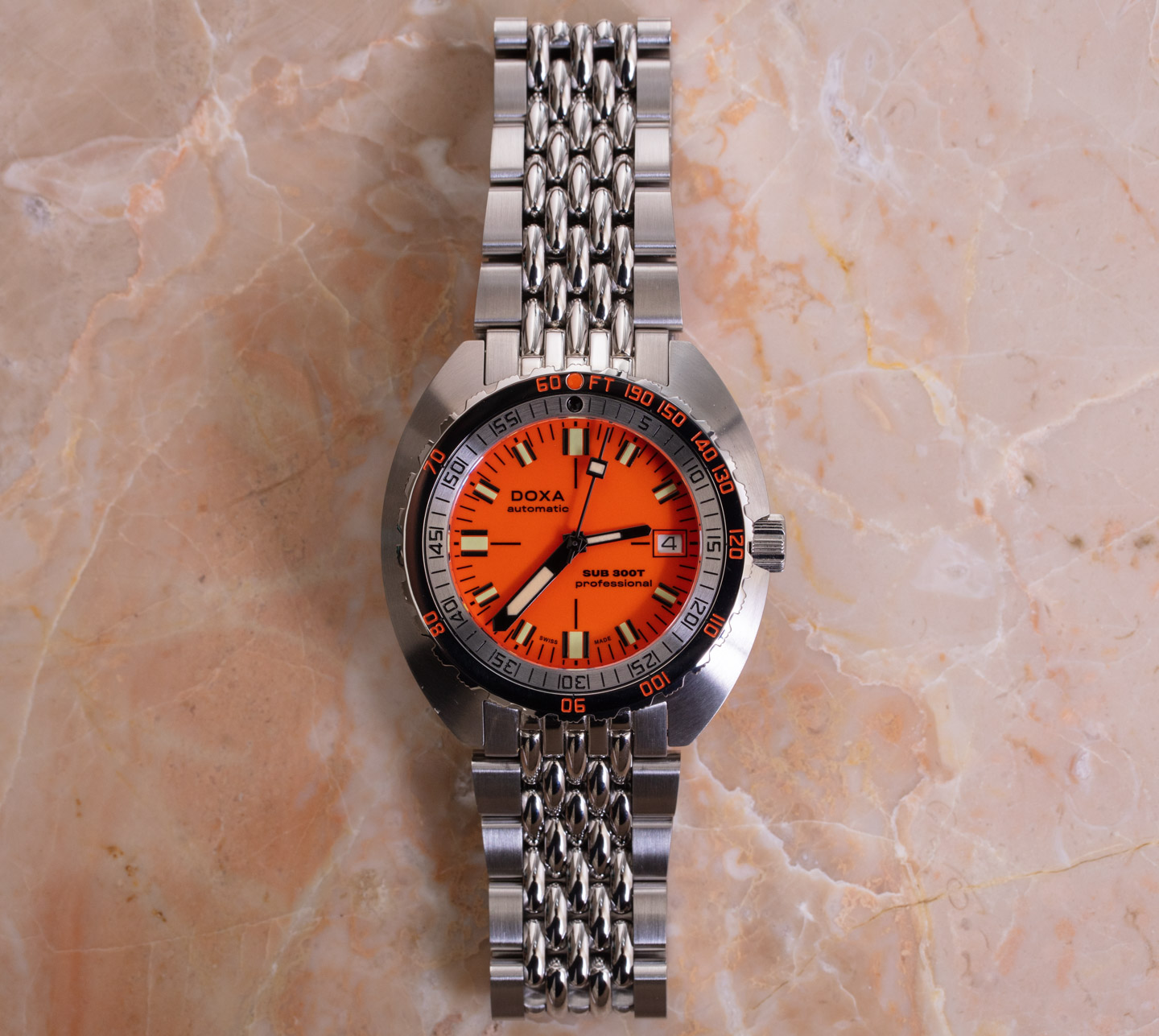
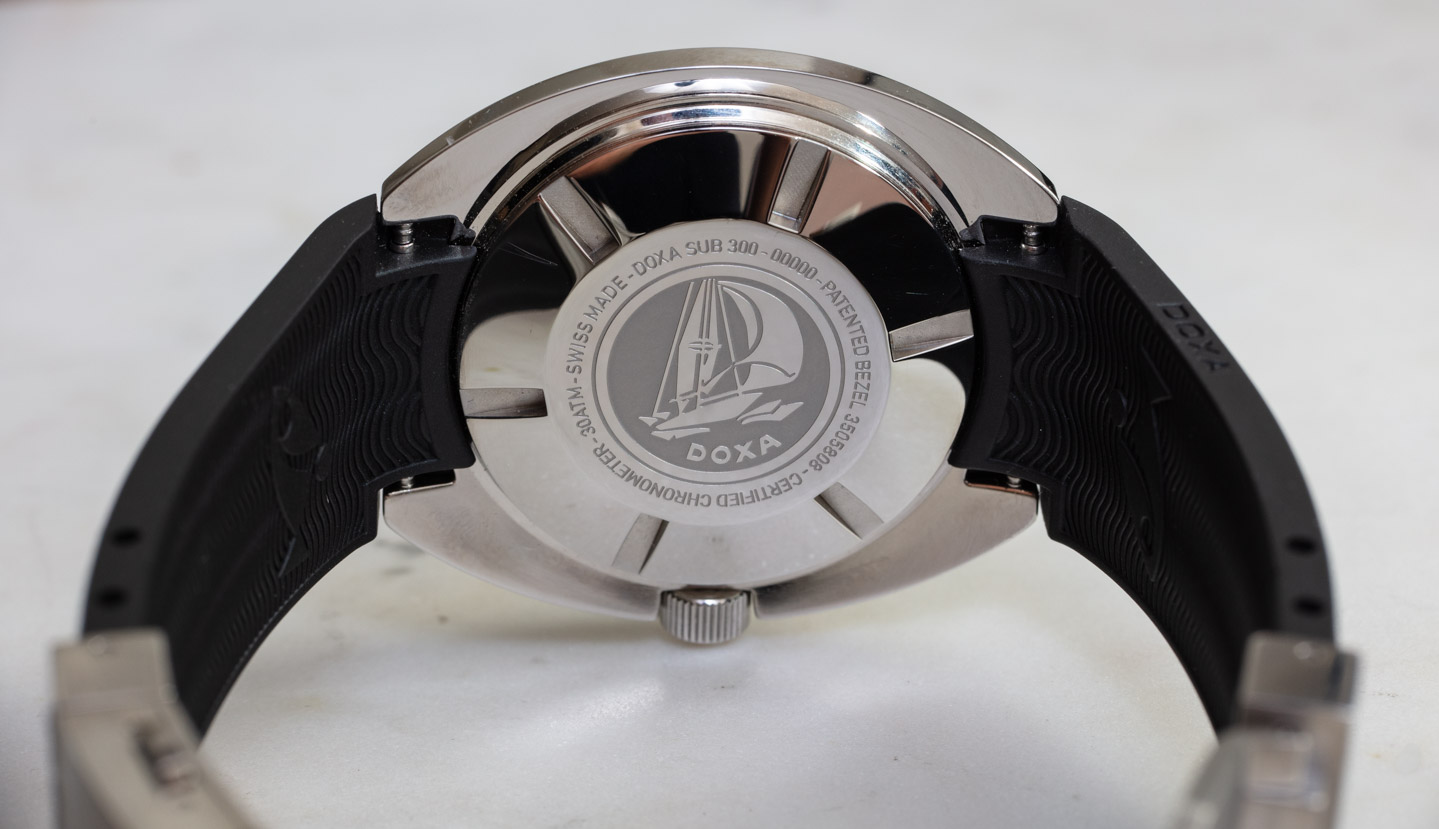
Given the historic importance of the orange dial. Doxa calls its SUB 300 and SUB 300T watches with the orange dials “Professional.” Other models get different names. For example, this silver dial model is called the SUB 300 Searambler. One of the most interesting stories about the Doxa SUB 300T is how it entered contemporary pop culture through the late diving and action story writer Clive Cussler. In his books, main character Dirk Pitt works a Doxa SUB 300T Professional watch — and apparently, this fact was mentioned a number of times in novels.
Clive Cussler himself was a diver and worked for a while at a diver’s shop while he started out as a writer. Apparently, Cussler was gifted a Doxa SUB 300T by the diving equipment store manager and liked it so much he decided that the main character of his book also had to wear one. While it is true that the books featured the SUB 300T, the stories might as well have included the SUB 300, as the utility they would offer the main character are arguably identical.

The Doxa SUB 300 and SUB 300T watches are rather adept at their main purpose — being a diver’s watch. One of the other iconic elements of the watch is the patented unidirectional metal bezels that include one ring for a 60-minuter counter and another ring for an NDL (no-decompression-limit) scale that is (was) imminently useful for divers ascending back to the surface who don’t want to get and decompression sickness.
The timepiece world has no shortage of diver’s style watches. What makes Doxa so special given its cult-list fan status? I’m not entirely sure, but my guess is that Doxa watches have a unique historic relationship with the emergence of modern recreational diving (Doxa consulted with such greats as Jacques Cousteau while developing it. Second, Doxa watches have their own, highly distinctive, and rather friendly-looking designs. This latter sense of design distinction is what I think seals Doxa as a desirable diver’s watch for many people.
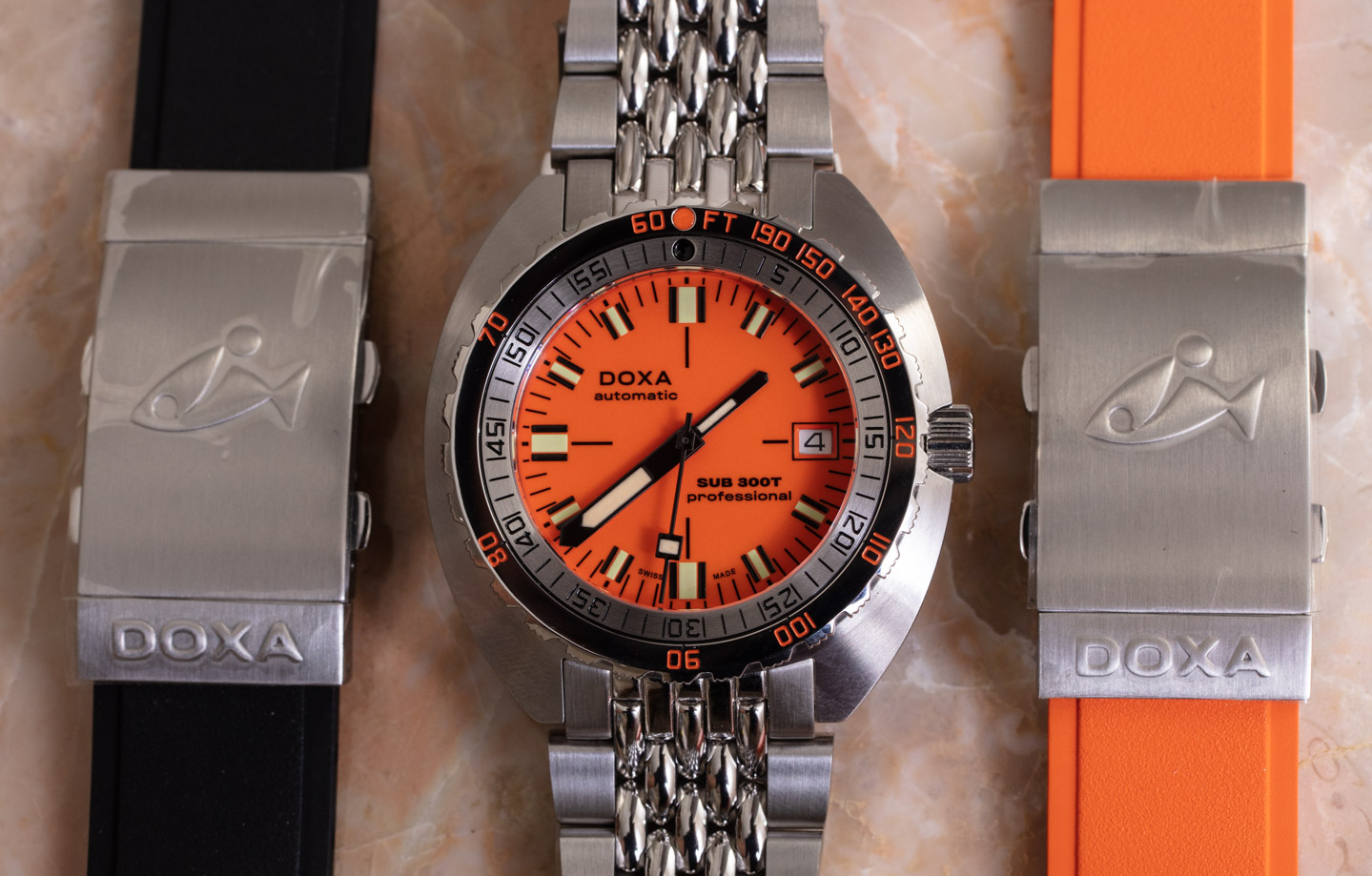
I find Doxa’s particular consumer success to be interesting given the wide array of other diver’s watches on the market. Arguably, there isn’t anything that Doxa diver’s watches do that other models on the market can’t do, and yet the Doxa name and core retro design hold enormous appeal for enthusiasts. Why is that? I will offer two answers.
The first answer is how the SUB 300/300T design looks. Indeed it is a vintage-inspired design very similar to the original. On top of that, Doxa didn’t just come out with a SUB 300 or SUB 300T re-issue, but for the most part has been producing these designs for several years similar to how Rolex has consistently produced a recognizable Submariner, or Porsche a recognizable 911. That has helped make the Doxa 300T a real cultural icon.
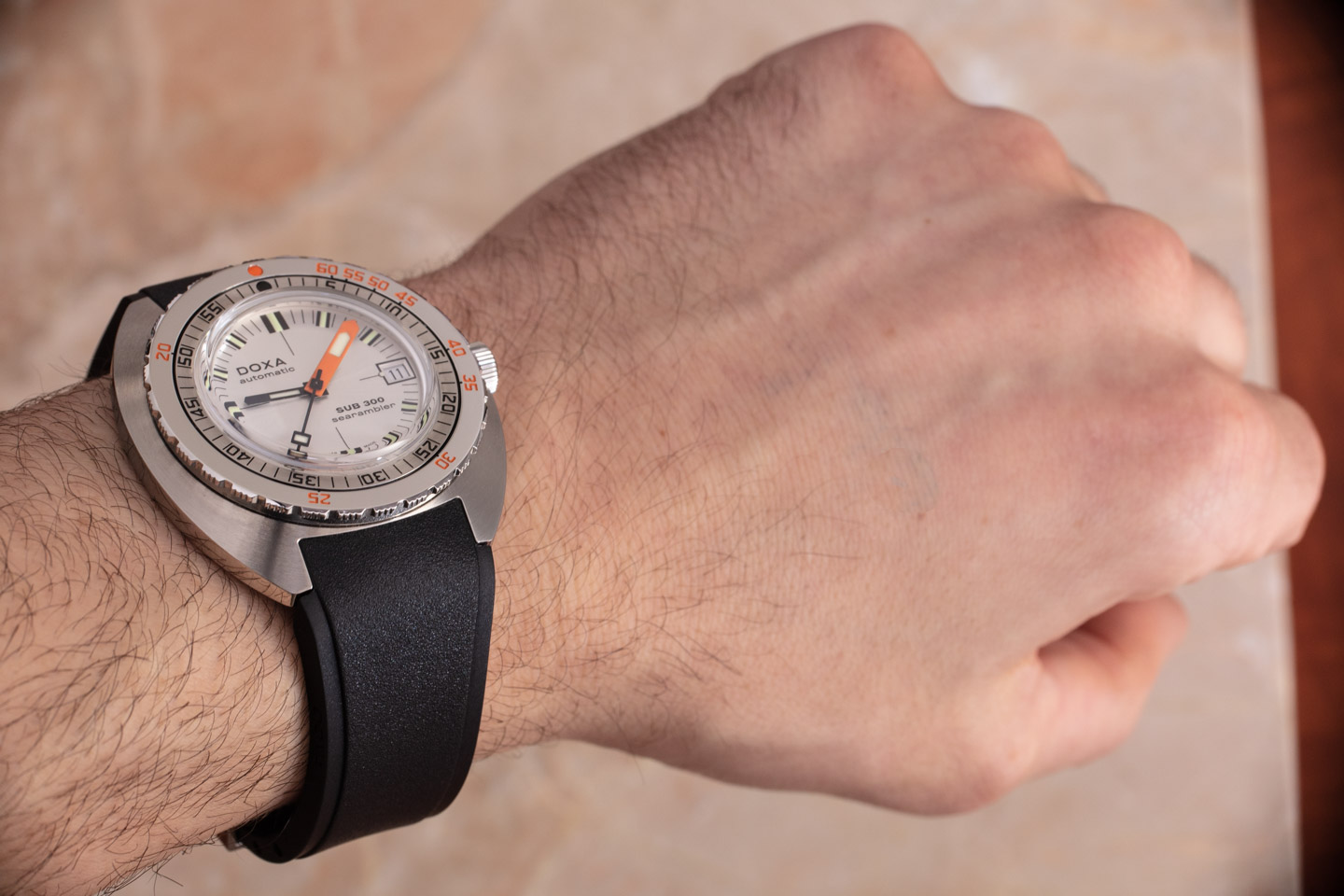
The tonneau-style case in polished steel is quirky but handsome. It sort of looks like a flying saucer spaceship on your wrist and wears really comfortably. The “double” bezel has two rings, which again is a trademark Doxa aesthetic. Everything from the case to the hands, bezel, and dial are elements we don’t see being copied by other brands. So when you see this look, you know it is a Doxa.
Whether or not you find the look of the SUB 300/300T appealing, they do grow on you given their overall comfort and success as tool watches. I think this design has appeal because Doxa never stopped making sure the SUB 300 family was a good tool watch. Even though the dial is comparatively small given the case size, it remains very legible. Even the unique looking bezel is easy to grasp and turn, even with gloves. So, as a tool/functional watch, Doxa offers a nice package with the SUB 300 and SUB 300T.

The dial design evokes the original design for diving back in the 1960s. The minute hand is “outsize” because that is mainly what divers look at when underwater and the bezel represents dual scales of necessary information (back when divers didn’t have diving computers). Doxa originally determined that orange was the ideal dial color for optimal underwater legibility. For that reason, the orange-colored version is known as the SUB 300T Professional, while the other dial colors have different names. As I mentioned, this silver-toned dial is known as the SUB 300 Searambler. The other four colors (yellow, black, aquamarine and navy blue all have their own character-rich titles. Over the dial of the SUB 300 is a “box-style” AR-coated sapphire crystal, which has a look meant to evoke the original acrylic crystals originally used on the watches starting in the late 1960s. As I said above, the SUB 300T has a more flush crystal.
Part of the iconic look of the SUB 300 and SUB 300T is Doxa’s “beads of rice” style bracelet, which has five columns of polished “beads of rice” links between more traditional brushed links on the sides. The bracelet is well made and flows elegantly over the wrist. This aesthetic style of bracelet isn’t unique to Doxa, but for a long time, Doxa was among the only brands still producing such bracelets. More recently, these bracelets are coming back in fashion, with notable watches such as the TAG Heuer Auatavia Heuer 02 Chronograph being available with similar bracelets. These nevertheless still offer a compelling look when matched with the iconic Doxa SUB 300/300T case.
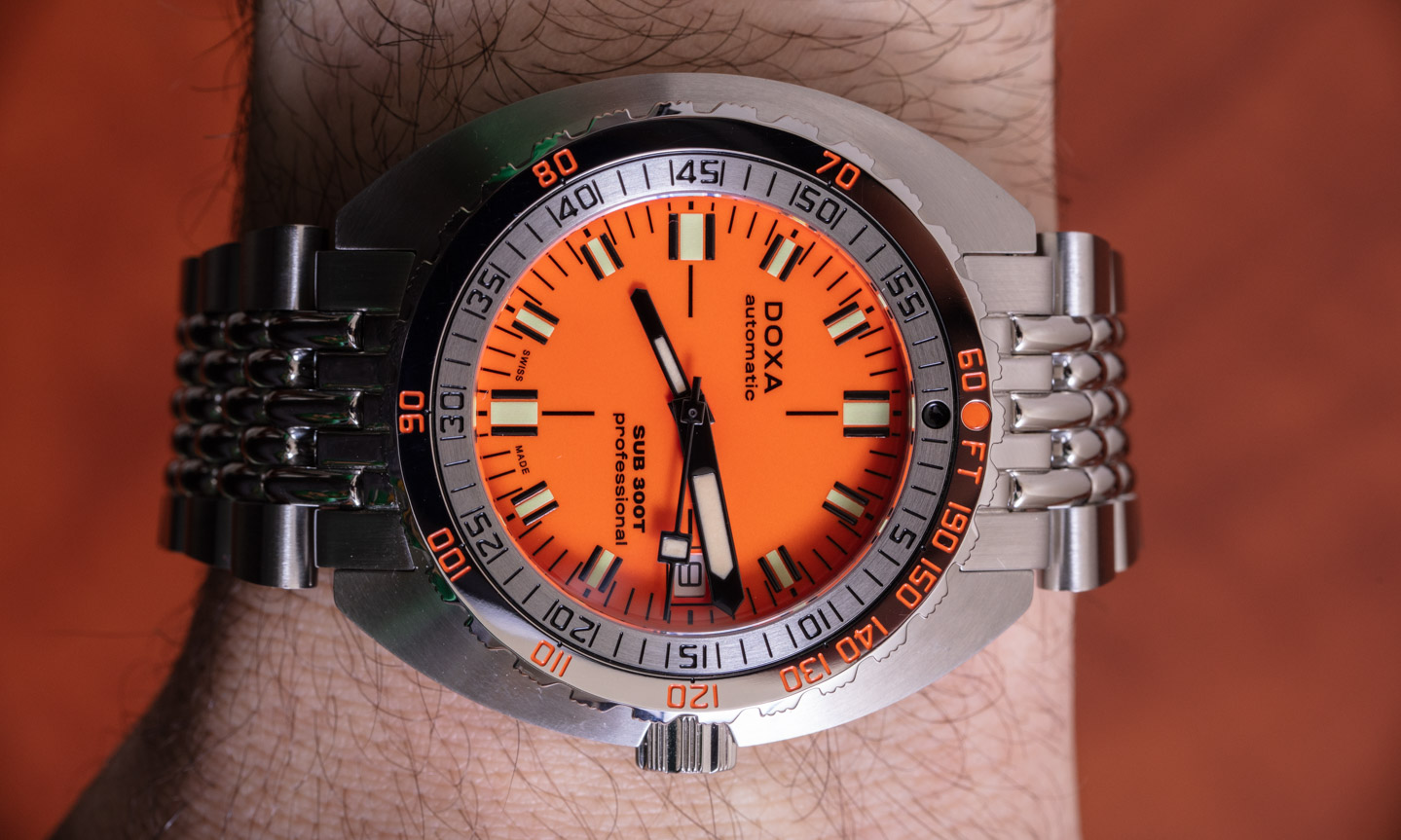
In addition to the steel metal bracelet option, Doxa also offers black (or dial-matching color) natural rubber straps that are neatly fitted to the cases. The straps need to be cut to size, but both the straps and the bracelet come on steel deployant straps that further have a micro-adjust system in them. I found both options comfortable to wear and handsome. The pieces look especially cool when you match the color of the dial with the rubber strap (for a particularly stylish result).
Doxa’s history, quality, and quirkiness make for an excellent foundation for a cult classic watch, which the SUB 300 and SUB 300T most certainly are. While not for everyone, I most certainly encourage all serious watch lovers to try out a SUB 300/300T for a bit to see how they like it. Putting the watch on your wrist is a different experience than merely seeing pictures of other people wearing them.
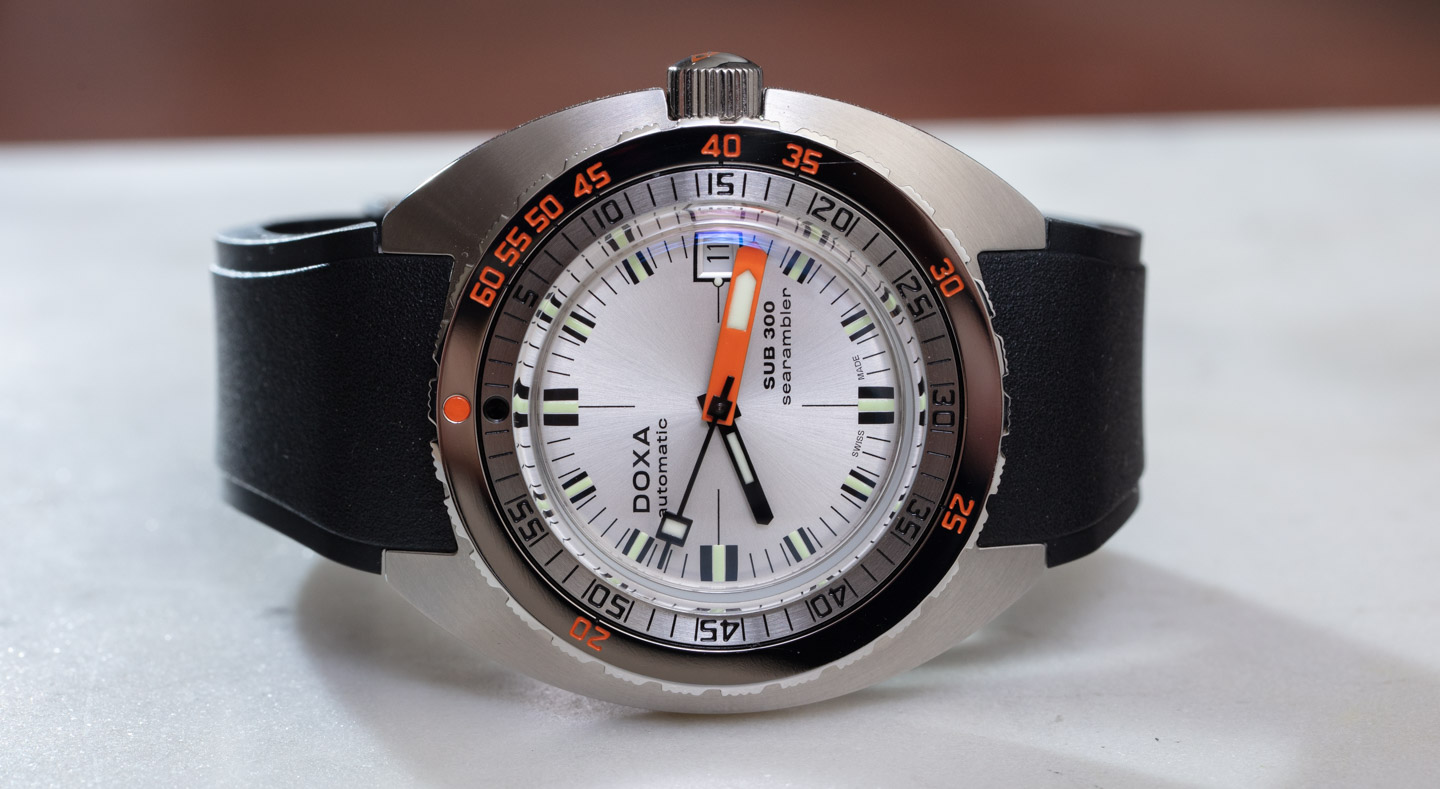
Consider me a bit perplexed as to why Doxa concurrently sells both the SUB 300 and SUB 300T models. While there are differences, the two timepieces arguably compete with one another or merely make it challenging for consumers to decide which to get. There are already enough dial colors to choose from. Doxa’s response as to why they produce both is probably because both sell (possibly to different consumers). Just don’t feel bad if you are having trouble deciding between the SUB 300 and SUB 300T — as I am not even sure which of the two I would personally prefer if I had to choose one. I might very well choose the SUB 300 watches if only because they are slightly more enthusiast-grade with the COSC Chronometer movements, and because the cases are a bit slimmer than the SUB 300T – which has more water resistance than I’ll personally ever need. Price for the Doxa SUB 300 on the rubber strap (reference 821.10.021.20 Searambler as seen) is $2,450 (it would be $2,490 USD on the metal bracelet). Price for the Doxa SUB 300T (reference 840.10.351.10 SUB 300T Professional as see) is $1,890 USD (and it would cost $1,850 USD on the rubber strap). Learn more or order at the Doxa website here.
Necessary Data
>Brand: Doxa
>Model: SUB 300 and SUB 300T (SUB 300T Professional and SUB 300 Searambler as tested)
>Price: $1,850 – $1,890 for the SUB 300T and $2,450 – $2,490 USD for the SUB 300
>Size: 42.5mm-wide, 13.4mm-thick, and 45mm lug-to-lug distance.
>When reviewer would personally wear it: For diving, or for daily desk diving. It works just as well for both uses.
>Friend we’d recommend it to first: Tool-watch lovers keen to own a real piece of diver’s watch history (that is also pretty cool looking).
>Best characteristic of watch: Nice blend of features, heritage, style, and decent price. Exactly what a lot of timepiece collectors today are looking for.
>Worst characteristic of watch: Doxa makes selecting a product challenging given potentially redundant offers between the two collections. Dial is comparatively narrow when considering case size. Dial is relatively flat where applied markers would have given a slightly better sense of depth (but would not have been as historically accurate).

